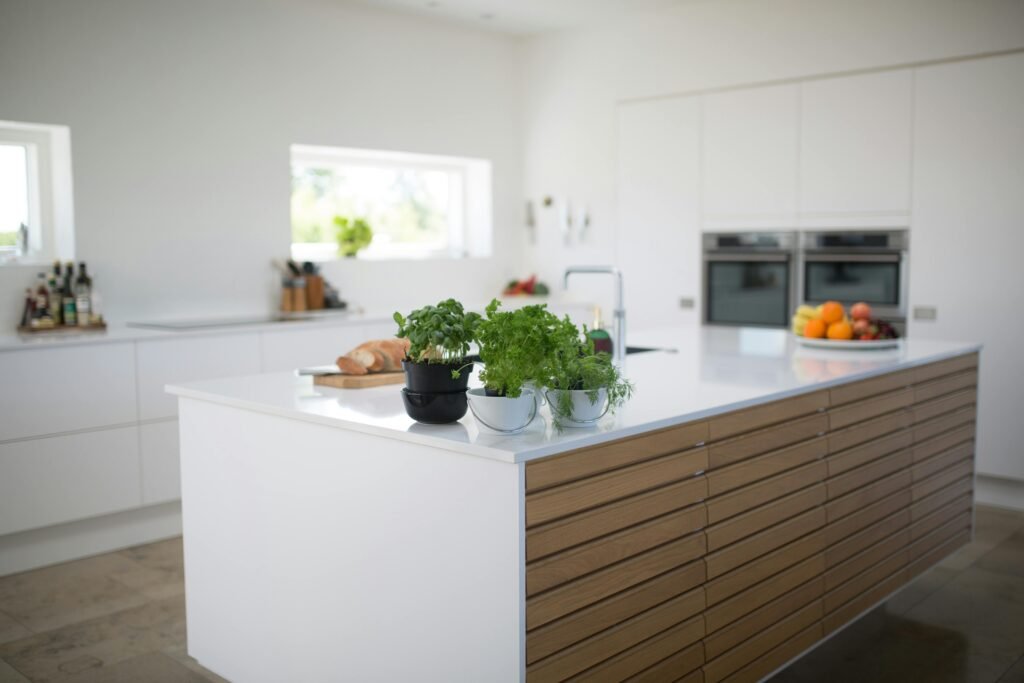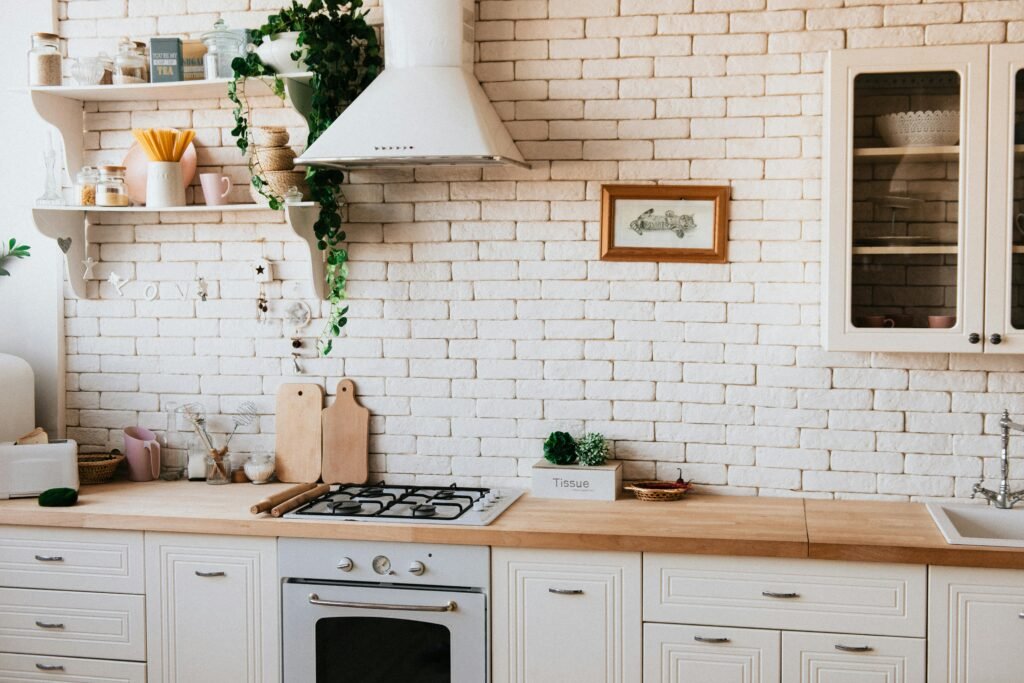10 Simple Swaps for a More Sustainable Kitchen: Easy Changes for a Greener, Healthier Home

Introduction
Swaps for a More Sustainable Kitchen: The kitchen is often the busiest part of any home, but it’s also one of the biggest contributors to waste and environmental damage. From disposable plastics to resource-heavy appliances and chemical-laden cleaning supplies, our everyday kitchen habits can have a lasting impact on the planet. Fortunately, creating a more sustainable kitchen doesn’t require major changes.
By making a few intentional swaps, you can significantly reduce waste, lower your carbon footprint, and promote a healthier environment for your family and the Earth. In this post, we’ll guide you through 10 simple, eco-friendly changes that are practical, affordable, and designed to help you create a greener, more sustainable kitchen. These steps prove that small actions really can make a big difference!

1. Ditch Plastic Wrap for Beeswax Wraps
Plastic wrap is one of the most wasteful kitchen items, contributing to pollution and landfill overflow due to its non-biodegradable nature. By making the simple swap to beeswax wraps, you embrace an innovative, sustainable alternative that combines functionality with environmental consciousness. These wraps are crafted from natural materials like cotton fabric coated with beeswax, tree resin, and jojoba oil. Their breathable and flexible texture creates a natural seal, making them an effective swap for single-use plastic.
Beeswax wraps are incredibly versatile—you can swap them in for plastic wrap to cover bowls, wrap sandwiches, or store fruits and vegetables. They’re durable and can be cleaned easily with cool water and mild soap, allowing for repeated use, making them a great eco-friendly swap. Once worn out, they’re fully compostable, offering a zero-waste solution. By making the swap to beeswax wraps, you’ll significantly reduce plastic waste while adding an eco-friendly flair to your kitchen.
2. Replace Paper Towels with Reusable Cloths
Plastic wrap is one of the most wasteful kitchen items, contributing to pollution and landfill overflow due to its non-biodegradable nature. By making the simple swap to beeswax wraps, you embrace an innovative, sustainable alternative that combines functionality with environmental consciousness. These wraps are crafted from natural materials like cotton fabric coated with beeswax, tree resin, and jojoba oil. Their breathable and flexible texture creates a natural seal, making them an effective swap for single-use plastic.
Beeswax wraps are incredibly versatile—you can swap them in for plastic wrap to cover bowls, wrap sandwiches, or store fruits and vegetables. They’re durable and can be cleaned easily with cool water and mild soap, allowing for repeated use, making them a great eco-friendly swap. Once worn out, they’re fully compostable, offering a zero-waste solution. By making the swap to beeswax wraps, you’ll significantly reduce plastic waste while adding an eco-friendly flair to your kitchen.

3. Swap Plastic Food Containers for Glass or Stainless Steel
Plastic food containers, while convenient, pose environmental and health risks. Over time, they can leach harmful chemicals like BPA and phthalates into your food, especially when exposed to heat. Swapping plastic containers for glass or stainless steel is a safer, more sustainable choice.
Swapping to glass containers is a smart move, as they are durable, microwave- and oven-safe, and ideal for storing and reheating meals. Swapping to stainless steel containers offers even more benefits—they’re lightweight, unbreakable, and perfect for packed lunches or outdoor use. These swaps are long-lasting, recyclable, and reduce the need for frequent replacements, minimizing plastic waste. Though the initial investment might be higher, making the swap to these materials offers significant long-term benefits, both in safety and sustainability, making them a worthwhile upgrade for any eco-friendly kitchen.
4. Switch Single-Use Coffee Pods for a Reusable Filter
Single-use coffee pods are convenient, but they create a shocking amount of plastic and aluminum waste. Swaps like switching to a reusable coffee filter or a French press offer simple yet effective ways to enjoy your daily coffee while reducing waste.
Swaps to reusable coffee filters made from stainless steel or fine mesh fit seamlessly into most coffee makers. These filters are easy to clean and deliver the same rich flavor without generating waste from single-use pods. Another excellent swap is using a French press, which offers a filter-free, completely waste-free option for brewing coffee. These eco-friendly swaps minimize your environmental impact while also cutting down on the ongoing costs of single-use pods.

5. Choose Refillable or Solid Dish Soap Options
Dishwashing soap is another common source of single-use plastic waste. Most brands package their liquid soap in disposable plastic bottles, which often end up in landfills or oceans. Swaps like switching to refillable dish soap options or solid soap bars can make a significant difference in your kitchen’s sustainability.
Many eco-friendly stores offer bulk refill stations where you can bring your own containers to refill liquid soap. These swaps reduce the need for disposable plastic bottles. Solid dish soap bars are another great swap, often packaged in compostable or recyclable materials. These alternatives are just as effective as traditional dish soap but come with the added benefit of reducing plastic waste. Swapping to refillable or solid soap options in your kitchen is a small yet impactful step toward a zero-waste lifestyle.
6. Use Compostable Sponges Instead of Synthetic Ones
Most kitchen sponges are made from synthetic materials like plastic and polyurethane, which take years to decompose and contribute to landfill waste. Compostable sponges made from natural fibers, such as cellulose, loofah, or coconut coir, provide a sustainable alternative.
These biodegradable sponges are just as effective at cleaning dishes and surfaces as their synthetic counterparts. Once they’ve reached the end of their life, they can be composted, significantly reducing the amount of waste generated by your kitchen. Switching to compostable sponges is an easy way to align your cleaning habits with eco-friendly principles.

7. Choose Eco-Friendly Dishwashing Detergent
Conventional dishwashing detergents often contain harsh chemicals and come in single-use plastic packaging, both of which are harmful to the environment. Eco-friendly dishwashing detergents, on the other hand, are biodegradable, non-toxic, and come in sustainable packaging options like refillable containers or solid tablets.
These green alternatives protect waterways from harmful chemicals while ensuring your dishes are cleaned effectively and safely. Choosing an eco-friendly detergent is a simple yet significant way to reduce your kitchen’s environmental footprint and promote a healthier home.
8. Install a Water-Saving Faucet Aerator
Water conservation is a key component of sustainable living. A water-saving faucet aerator is an inexpensive and easy-to-install device that reduces water flow without compromising performance.
By limiting the amount of water used during washing or rinsing, aerators help conserve this valuable resource and lower your utility bills. This small upgrade is an efficient way to make your kitchen more eco-friendly while cutting down on water waste.

9. Shop Pantry Staples in Bulk
Purchasing pantry staples like grains, nuts, and spices in bulk can drastically reduce packaging waste. Many stores now offer bulk bins where you can fill reusable containers or bags, eliminating the need for disposable plastic or cardboard packaging.
Bulk shopping not only reduces waste but also allows you to buy only what you need, minimizing food waste. It’s a simple, cost-effective habit that supports sustainable shopping practices and keeps your kitchen well-stocked with eco-friendly ingredients.
10. Replace Plastic Cooking Utensils with Bamboo or Wooden Alternatives
Plastic cooking utensils often melt, break, and release harmful chemicals into food when exposed to heat. Bamboo and wooden utensils are excellent eco-friendly replacements.
Bamboo is a fast-growing, renewable resource that requires minimal water and no pesticides, making it an environmentally friendly option. Wooden utensils are durable, biodegradable, and free from chemicals like BPA, ensuring safe and sustainable cooking. Switching to bamboo or wooden tools not only reduces plastic use but also enhances your kitchen’s natural aesthetic.
Conclusion
Creating a sustainable kitchen is simpler than you might think. By swapping plastic wrap for reusable beeswax wraps, switching to glass or stainless steel containers, and opting for eco-friendly cleaning products, you can make numerous swaps that reduce waste, conserve resources, and minimize exposure to harmful chemicals. These sustainable swaps not only lower your kitchen’s environmental impact but also save money and promote a healthier lifestyle.
Every step you take toward sustainability—whether it’s swapping out single-use plastics for reusable alternatives or choosing natural cleaning products—brings us closer to a cleaner, greener future. Start today and make your kitchen a hub for eco-friendly living by incorporating more sustainable swaps into your routine!




